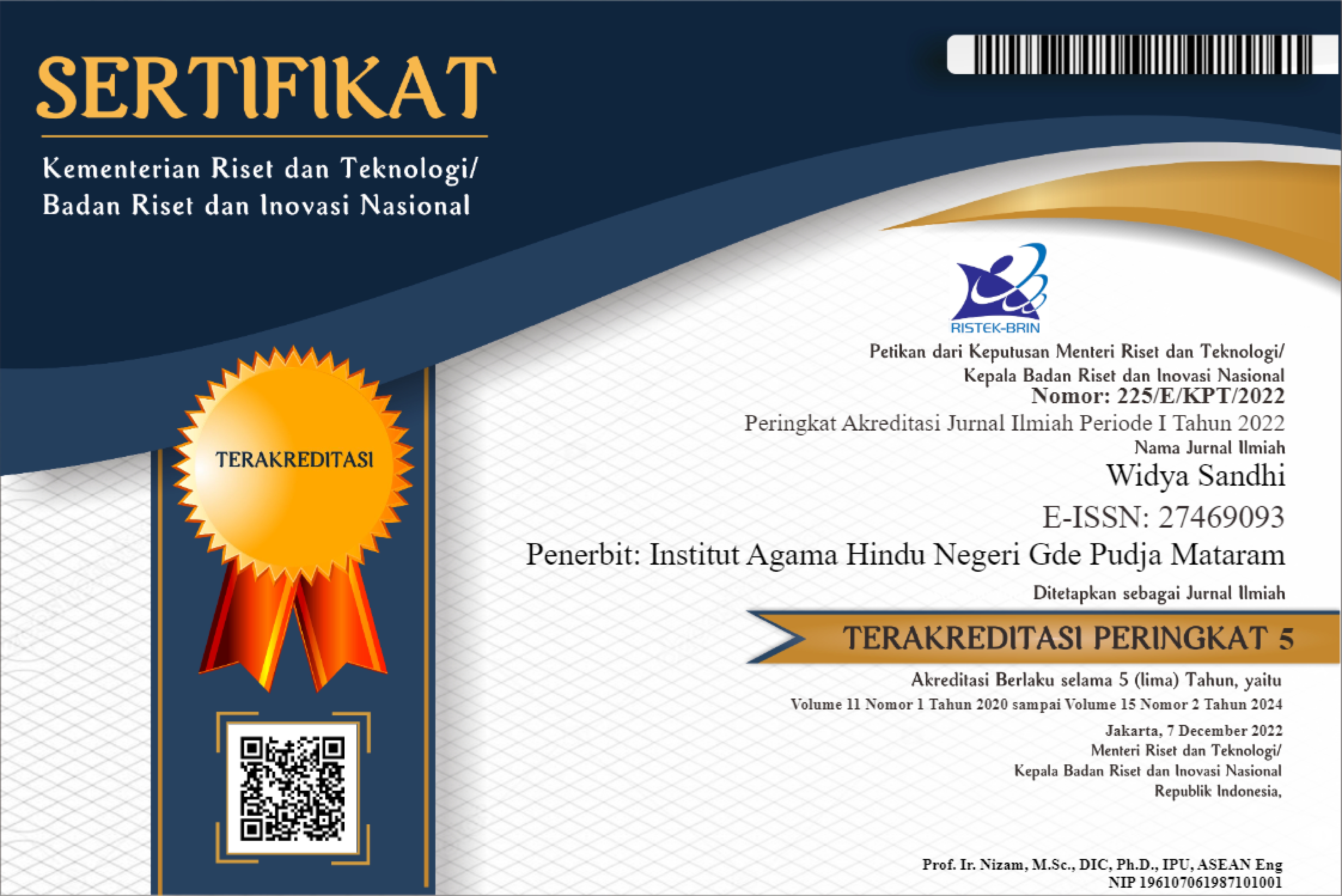SIMBOL KEBO SEBAGAI SARANA UPACARA DEWA YADNYA DI PURA GUNUNG PANGSUNG KECAMATAN LABUAPI KABUPATEN LOMBOK BARAT
Abstract
This study aims to conduct a study of the implementation of the dewa yadnya (ceremony for God) which uses symbol of kebo as a means of upbringing on the pujawali (ceremony) in Gunung Pangsung Temple, Labuapi District, West Lombok Regency. This research was designed in the form of qualitative descriptive research with the presentation of data in the form of words, sentences, opinions, and the like in order to find answers to the formulated problem. The focus of this research is to examine the form, function, and meaning of the implementation of the dewa yadnya (ceremony for God) which uses the kebo symbol as a means of upakara.
Based on data and data analysis, this study found that the form of performing the ceremony of dewa yadnya (ceremony for God) using kebo animal as a symbol of ceremonial means in Gunung Pangsung Temple represented a belief system of Hindus by using symbolic forms in accordance with religious conditions inherited from ancestors in the past. This is as part of the realization of sradha and bhakti in order to improve the quality of their lives in this world. The function of performing the ceremony of the dewa yadnya that uses kebo as a symbol of the ceremony facilities at Gunung Pangsung Temple involves religious functions related to the implementation of beliefs, social togetherness functions to establish togetherness and the function of cultural preservation to continue the cultural traditions of the ancestral heritage. The meaning contained in the implementation of the ceremony of the dewa yadnya which uses kebo as a symbol of ceremonial means at Gunung Pangsung Temple concerns the meaning of increasing religious awareness, togetherness in performing rituals, and passing on the noble cultural values of the past in order to improve the quality of their lives.
Based on the above results, the implementation of dewa yadnya that uses the kebo symbol is very important as a medium for implementing Hindu beliefs in order to improve the quality of life needs to be preserved because it can bring togetherness in the father's rules that can create harmony among Hindus and contain elements of preservation cultural heritage of ancestors
References
¬¬¬¬¬¬¬¬¬¬¬¬¬¬¬¬¬¬¬¬¬¬¬¬¬¬¬¬¬¬¬¬Arikunto, Suharsimi, 2002. Prosedur Penelitian Suatu Pendekatan Praktek. Jakarta : Rhineka Cipta.
Glebet, I Nyoman, dkk, 2002. Arsitektur Tradisional Daerah bali. Badan Pengembangan Kebudayaan dan Pariwisata Deputi Bidang Pelestarian dan Pengembangan Budaya Bagian Proyek Pengkajian dan Pemanfaatan Sejarah dan Tradisi Bali.
Gulo, W, 2004. Metodologi Penelitian. Jakarta : Gramedia.
Miles, B Matthew dan Huberman, A Michael, 1992. “Analisis Data Kualitatif”. Jakarta : Universitas Indonesia (UI-Press).
Moleong, Lexy, J, 2002. Metodologi Penelitian Kualitatif. Bandung : PT. Remaja Rosda Karya.
Moscovinci S, 2000. Social representations. Cambridge: Polity Press.
O’Dea, Thomas E, 1985. Sosiologi Agama Suatu Pengantar Awal. Jakarta:CV Rajawali.
Pals, Daniel, 2001. Seven Theories of Religion. Yogyakarta : Penerbit Qalam.
Sugiyono, 2008. Metode Penelitian Kuantitatif - Kualitatif Dan R & D. Bandung: Alfabeta.
Sujana, Nana dan Awal Kusumah, 2004. Proposal Penelitian di Perguruan Tinggi. Bandung : Sinar Baru Algesindo.
Suprayogo, Imam dan Tabroni, 2001. Metodologi Penelitian Sosial-Agama. Bandung : PT. Remaja Rosdakarya.
Surayin, Ida Ayu Putu. 2005. Seri I Upakara Yajna: Melangkah ke Arah Upakara-Upacara Yajna. Surabaya: Paramitha.
Tanu, I Ketut. 2016. “Penonjolan Konsep Seremonial Mengurangi Nilai Spiritual Perspektif Yadnya Umat Hindu di Bali”. Denpasar : Jurnal Vidya Samhita: Jurnal Penelitian Agama halaman 10-20.
Titib, I Made, 2003. Teologi Dan Simbol-Simbol Dalam Agama Hindu. Surabaya: Paramita.
Triguna, I, B, Gede Yudha, 2000. Teori Tentang Simbol, Denpasar : Widya Dharma.
Sumber Internet :
http://cakepane.blogspot.co.id/2015/01/upakara-dan-upacara-dewa-yadnya.html diunduh 22 April 2018
(http://www.pps.unud.ac.id/thesis.html)
http://etd.repository.ugm.ac.id/index.Penelitian.html

This work is licensed under a Creative Commons Attribution-NonCommercial-ShareAlike 4.0 International License.
Authors who publish with this journal agree to the following terms:
- Authors retain copyright and grant the journal right of first publication with the work simultaneously licensed under a Creative Commons Attribution-ShareAlike 4.0 International License. that allows others to share the work with an acknowledgment of the work's authorship and initial publication in this journal.
- Authors are able to enter into separate, additional contractual arrangements for the non-exclusive distribution of the journal's published version of the work (e.g., post it to an institutional repository or publish it in a book), with an acknowledgment of its initial publication in this journal.
- Authors are permitted and encouraged to post their work online (e.g., in institutional repositories or on their website) prior to and during the submission process, as it can lead to productive exchanges, as well as earlier and greater citation of published work (See The Effect of Open Access).






.jpg)




